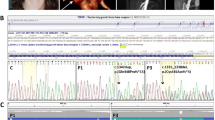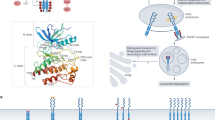Abstract
We report a family heterozygous for a newly identified mutation in the tyrosine kinase I domain of the FGFR2 gene (1576A>G, encoding the missense substitution Lys526Glu), associated with variable expressivity of Crouzon syndrome, including clinical nonpenetrance. Our observations expand both the clinical and molecular spectrum of this unusual subset of FGFR2 mutations.
Similar content being viewed by others

Log in or create a free account to read this content
Gain free access to this article, as well as selected content from this journal and more on nature.com
or
References
Cohen Jr MM, Kreiborg S : Birth prevalence studies of the Crouzon syndrome: comparison of direct and indirect methods. Clin Genet 1992; 41: 12–15.
Murdoch-Kinch CA, Ward RE : Metacarpophalangeal analysis in Crouzon syndrome: additional evidence for phenotypic convergence with the acrocephalosyndactyly syndromes. Am J Med Genet 1997; 73: 61–66.
Wilkie AOM, Patey SJ, Kan S-h, van den Ouweland AMW, Hamel BCJ : FGFs, their receptors, and human limb malformations: clinical and molecular correlations. Am J Med Genet 2002; 112: 266–278.
Reardon W, Winter RM, Rutland P, Pulleyn LJ, Jones BM, Malcolm S : Mutations in the fibroblast growth factor receptor 2 gene cause Crouzon syndrome. Nat Genet 1994; 8: 98–103.
Jabs EW, Li X, Scott AF et al: Jackson–Weiss and Crouzon syndromes are allelic with mutations in fibroblast growth factor receptor 2. Nat Genet 1994; 8: 275–279.
Muenke M, Wilkie AOM : Craniosynostosis syndromes; in: Scriver CR, Beaudet AL, Sly WS, Valle D (eds). The Metabolic and Molecular Bases of Inherited Disease, 8th edn. New York: McGraw-Hill, 2000, pp 6117–6146.
Kan S-h, Elanko N, Johnson D et al: Genomic screening of fibroblast growth-factor receptor 2 reveals a wide spectrum of mutations in patients with syndromic craniosynostosis. Am J Hum Genet 2002; 70: 472–486.
Coulier F, Pontarotti P, Roubin R, Hartung H, Goldfarb M, Birnbaum D : Of worms and men: an evolutionary perspective on the fibroblast growth factor (FGF) and FGF receptor families. J Mol Evol 1997; 44: 43–56.
Mohammadi M, Schlessinger J, Hubbard SR : Structure of the FGF receptor tyrosine kinase domain reveals a novel autoinhibitory mechanism. Cell 1996; 86: 577–587.
El Ghouzzi V, Heuertz S, Bonaventure J et al: Mutation analysis in Crouzon and Pfeiffer syndromes identifies novel substitutions in the tyrosine kinase regions of the fibroblast growth factor receptor-2 (FGFR-2). Eur J Hum Genet 2002; 10 (Suppl 1): 247.
Kan SH : Molecular genetics of human limb malformations: HOX genes and FGF pathways; DPhil Thesis, University of Oxford, 2003.
Neilson KM, Friesel RE : Constitutive activation of fibroblast growth factor receptor-2 by a point mutation associated with Crouzon syndrome. J Biol Chem 1995; 270: 26037–26040.
Robertson SC, Meyer AN, Hart KC, Galvin BD, Webster MK, Donoghue DJ : Activating mutations in the extracellular domain of the fibroblast growth factor receptor 2 function by disruption of the disulfide bond in the third immunoglobulin-like domain. Proc Natl Acad Sci USA 1998; 95: 4567–4572.
Oldridge M, Lunt PW, Zackai EH et al: Genotype–phenotype correlation for nucleotide substitutions in the IgII–IgIII linker of FGFR2. Hum Mol Genet 1997; 6: 137–143.
Everett ET, Britto DA, Ward RE, Hartsfield JK : A novel FGFR2 gene mutation in Crouzon syndrome associated with apparent nonpenetrance. Cleft Palate Craniofac J 1999; 36: 533–541.
Johnson D, Wall SA, Mann S, Wilkie AOM : A novel mutation, Ala315Ser, in FGFR2: a gene–environment interaction leading to craniosynostosis? Eur J Hum Genet 2000; 8: 571–577.
Acknowledgements
We thank the family for their help with this study, and the Wellcome Trust for financial support (AOMW).
Author information
Authors and Affiliations
Corresponding author
Rights and permissions
About this article
Cite this article
de Ravel, T., Taylor, I., Van Oostveldt, A. et al. A further mutation of the FGFR2 tyrosine kinase domain in mild Crouzon syndrome. Eur J Hum Genet 13, 503–505 (2005). https://doi.org/10.1038/sj.ejhg.5201325
Received:
Revised:
Accepted:
Published:
Issue date:
DOI: https://doi.org/10.1038/sj.ejhg.5201325
Keywords
This article is cited by
-
Craniosynostosis as a clinical and diagnostic problem: molecular pathology and genetic counseling
Journal of Applied Genetics (2018)


